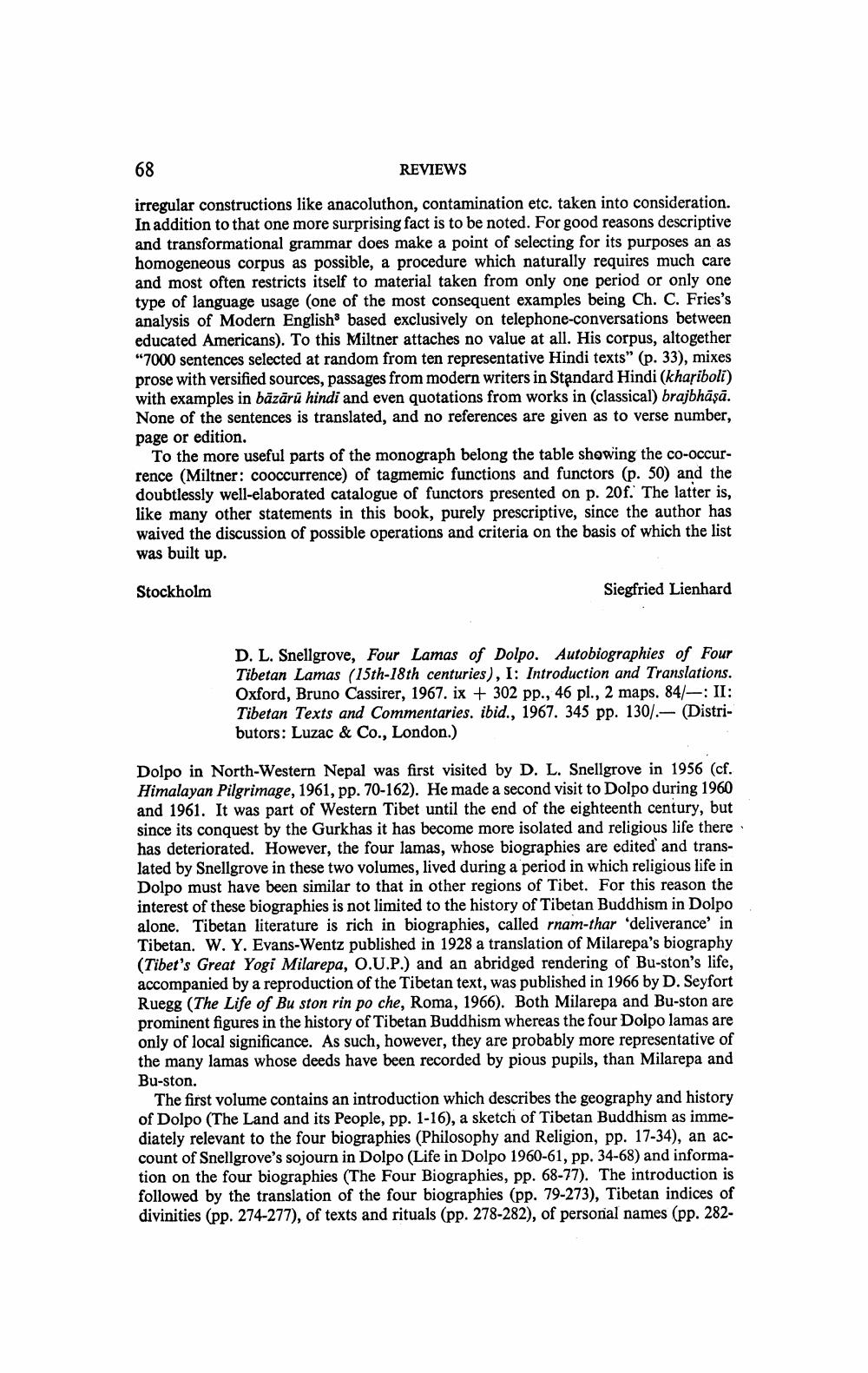________________ 68 REVIEWS irregular constructions like anacoluthon, contamination etc. taken into consideration. In addition to that one more surprising fact is to be noted. For good reasons descriptive and transformational grammar does make a point of selecting for its purposes an as homogeneous corpus as possible, a procedure which naturally requires much care and most often restricts itself to material taken from only one period or only one type of language usage (one of the most consequent examples being Ch. C. Fries's analysis of Modern English: based exclusively on telephone-conversations between educated Americans). To this Miltner attaches no value at all. His corpus, altogether "7000 sentences selected at random from ten representative Hindi texts" (p. 33), mixes prose with versified sources, passages from modern writers in Standard Hindi (khariboli) with examples in bazaru hindi and even quotations from works in (classical) brajbhasa. None of the sentences is translated, and no references are given as to verse number, page or edition. To the more useful parts of the monograph belong the table showing the co-occurrence (Miltner: cooccurrence of tagmemic functions and functors (p. 50) and the doubtlessly well-elaborated catalogue of functors presented on p. 20f. The latter is, like many other statements in this book, purely prescriptive, since the author has waived the discussion of possible operations and criteria on the basis of which the list was built up. Stockholm Siegfried Lienhard D. L. Snellgrove, Four Lamas of Dolpo. Autobiographies of Four Tibetan Lamas (15th-18th centuries), I: Introduction and Translations. Oxford, Bruno Cassirer, 1967. ix + 302 pp., 46 pl., 2 maps. 84/-: II: Tibetan Texts and Commentaries. ibid., 1967. 345 pp. 130/.- (Distributors: Luzac & Co., London.) Dolpo in North-Western Nepal was first visited by D. L. Snellgrove in 1956 (cf. Himalayan Pilgrimage, 1961, pp. 70-162). He made a second visit to Dolpo during 1960 and 1961. It was part of Western Tibet until the end of the eighteenth century, but since its conquest by the Gurkhas it has become more isolated and religious life there has deteriorated. However, the four lamas, whose biographies are edited and translated by Snellgrove in these two volumes, lived during a period in which religious life in Dolpo must have been similar to that in other regions of Tibet. For this reason the interest of these biographies is not limited to the history of Tibetan Buddhism in Dolpo alone. Tibetan literature is rich in biographies, called rnam-thar "deliverance in Tibetan. W. Y. Evans-Wentz published in 1928 a translation of Milarepa's biography (Tibet's Great Yogi Milarepa, O.U.P.) and an abridged rendering of Bu-ston's life, accompanied by a reproduction of the Tibetan text, was published in 1966 by D. Seyfort Ruegg (The Life of Bu ston rin po che, Roma, 1966). Both Milarepa and Bu-ston are prominent figures in the history of Tibetan Buddhism whereas the four Dolpo lamas are only of local significance. As such, however, they are probably more representative of the many lamas whose deeds have been recorded by pious pupils, than Milarepa and Bu-ston. The first volume contains an introduction which describes the geography and history of Dolpo (The Land and its People, pp. 1-16), a sketch of Tibetan Buddhism as immediately relevant to the four biographies (Philosophy and Religion, pp. 17-34), an account of Snellgrove's sojourn in Dolpo (Life in Dolpo 1960-61, pp. 34-68) and information on the four biographies (The Four Biographies, pp. 68-77). The introduction is followed by the translation of the four biographies (pp. 79-273), Tibetan indices of divinities (pp. 274-277), of texts and rituals (pp. 278-282), of personal names (pp. 282




